|
|
|
Sort Order |
|
|
|
Items / Page
|
|
|
|
|
|
|
| Srl | Item |
| 1 |
ID:
091289
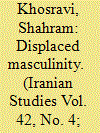

|
|
|
|
|
| Publication |
2009.
|
| Summary/Abstract |
Masculinity, like other kinds of social identity, is an ongoing construction in a dialogue between one's self-image and others' perceptions of one. The interplay between ethnicity and masculinity is a main theme in this article. Due to geographical displacement, the Iranian man's masculine identity has been challenged and renegotiated on the one hand by Iranian women's struggle for emancipation and on the other hand by the Swedish mediawork. Iranian men are displaced from the position of having a powerful gaze, which fixed and controlled women into a position of being an object of the gaze of others. The dominant gaze in Sweden makes them (in)visible in the same way their gaze makes women (in)visible in Iran.
|
|
|
|
|
|
|
|
|
|
|
|
|
|
|
|
| 2 |
ID:
085298
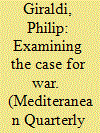

|
|
|
|
|
| Publication |
2008.
|
| Summary/Abstract |
Iran poses two fundamental challenges to the United States. First is its alleged program to develop a nuclear weapon, which is currently being negotiated and which might be managed and contained through concerted international action. Second, and more threatening in the long term, are its roles as a regional hegemon and as a participant in the political development of neighboring Iraq. Iran's policies in Iraq sometimes appear to be directly in conflict with US initiatives. In spite of considerable angry rhetoric, however, any actual evidence for Iranian hostile interaction in Iraq is highly speculative, and the White House has yet to make a case that Tehran's involvement is inappropriate or could serve as a casus belli.
|
|
|
|
|
|
|
|
|
|
|
|
|
|
|
|
| 3 |
ID:
084950
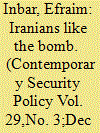

|
|
|
| 4 |
ID:
142762
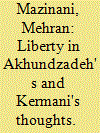

|
|
|
|
|
| Summary/Abstract |
Here I examine the modern idea of liberty in works of Akhundzadeh and Kermani – two leading Iranian intelligentsia under the Qajar Iran (1794–1925). In doing so, first, I set forth a brief (intellectual) background that shows some of the influences of Iranian, Russian, and European scholars on Akhundzadeh and Kermani. Then, their thoughts will be represented systematically by following a simple theoretical framework driven from their works. Applying one model to both cases particularly helps to demonstrate their similarities and differences, as well as how fundamentally different was their understanding of liberty from their contemporaries. To Akhundzadeh and Kermani, life under the Qajars resembled the lawless state of nature, transcending which, however, required more than establishing laws. For the transcendence to occur, a revolution in mind was needed; and for that matter to happen, liberty was a critical prerequisite and consequence.
|
|
|
|
|
|
|
|
|
|
|
|
|
|
|
|
| 5 |
ID:
157841


|
|
|
|
|
| Summary/Abstract |
Arədvī Sūrā Anāhitā, a popular Zoroastrian yazatā, is celebrated in Yašt 5 (Ābān Yašt). Anāhitā is mostly believed to be an Indo-Iranian or Iranian deity who has absorbed influences from the creed and iconography of Ishtar, the Mesopotamian goddess, in the course of history. The type and the degree of such influences are still under debate. The paper places this goddess into the context of ancient Western Asia. Findings are presented in two sections: in the first section, the Indo-Iranian, Iranian and western Iranian origins of Anāhitā are questioned, and in the following section two points are clarified: first, the Mesopotamian origin for Anāhitā is more consistent with historical and archaeological evidence, and second, Anāhitā is the same as Annunit/Annunitum, Sippar—Amnamum’s goddess of war and victory and the avatar of Antu, who was added to the list of his royal patron deities as a result of political and military developments early in the reign of Artaxerxes II.
|
|
|
|
|
|
|
|
|
|
|
|
|
|
|
|
| 6 |
ID:
183766


|
|
|
|
|
| Summary/Abstract |
A century ago, W.E.B. Du Bois coined the term ‘double consciousness’ to describe an individual with an identity with several facets, particularly in the context of African-American experiences. A century later, Du Bois’ theory was expanded into a concept called ‘triple consciousness’ to acknowledge the intersectional construction of identities where race might have intersected with ethnicity, gender, sexual orientation, etc. to generate complex, multivalent forms of subordination. Expanding Du Bois’ concept of ‘double consciousness’ to Chicana experiences, and disrupting nationalist Anglocentrism, in Borderlands/La Frontera, Gloria Anzaldúa theorized the ‘border’ as a metaphor for geographical transgressions, sexual boundary crossings, social displacements, and linguistic and cultural dislocations. In conversation with these theorists, I examine Iranian Armenian ‘multiple consciousnesses’, by highlighting their various expressions of diaspora, their many ways of longing to return to a homeland (Armenia and Iran), and their multiple collective consciousnesses, particularly the shared memories of the 1915 genocide. I also provide examples from cultural productions which demonstrate the diasporic transnationalism of Iranian Armenian authors who maintain ties with their homeland while are simultaneously anchored and settled in their host nations.
|
|
|
|
|
|
|
|
|
|
|
|
|
|
|
|
| 7 |
ID:
144714
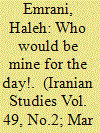

|
|
|
|
|
| Summary/Abstract |
Zoroastrians of Babylonia had long lived alongside an important Jewish community whose presence in the region can be traced back to the Achaemenid period (c. 550‒330 BCE). Such long coexistence should justify an interest in the examination of cultural sharing between these two religious groups of Ērānšahr; however, it is just recently that the question of the level of cultural contact between them has become a more important source of inquiry and research by scholars of Iranian history, religious studies and Late Antiquity. The exchanges between the Jews and Zoroastrians of the Sasanian period and their impact on the character of the Babylonian Talmud have been the subject of a number of recent studies, notably by Shaul Shaked, Yaakov Elman, Geoffrey Herman and Shai Segunda, among others. The aim of this article is to contribute to these efforts by exploring the roots of some distinctly Sasanian marriage customs that transcended religious lines and were shared by the rabbinic Jews and Zoroastrians of Ērānšahr.
|
|
|
|
|
|
|
|
|
|
|
|
|
|
|
|
|
|
|
|
|